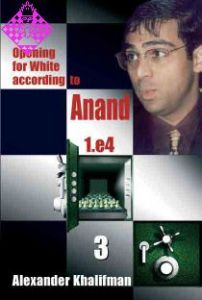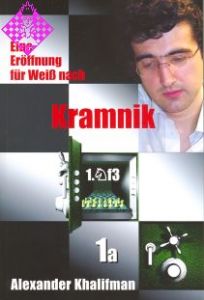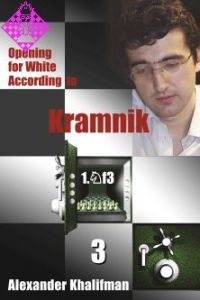Artikelnummer
LOKHAOFWATA13
Autor
Opening for White according to Anand - Vol. 13
Scheveningen 6.Be3 / Najdorf 5...a6 6.Be3 e6 7.f3
380 Seiten, kartoniert, Chess Stars, 1. Auflage 2010
Aus der Reihe »Opening for White according to Anand«
Preface
Dear readers,
You hold in your hands book 13 of the series "Opening for White According to Anand - 1.e4". This volume is devoted mostly to the English Attack in the Najdorf system, that is the variation beginning with 1.e4 c5 2.Nf3 d6 3.d4 cxd4 4.Nxd4 Nf6 5.Nc3 a6 6.Be3 e6 7.f3. White's plan is simple and clear in the majority of cases: Qd2, g4, castling long and then a pawn-offensive on the kingside. Naturally, Black cannot be happy following this script and he tries to create counterplay in the centre and on the queenside. There are numerous variations in which he leaves his king in the centre, since castling short early may turn out to be even more dangerous.
The Najdorf system has become the most popular in the Sicilian defence long long ago. Robert Fischer and Garry Kasparov were understandably its most famous exponents. Still, it looks like it will remain tremendously fashionable in the future as well. White began to play the English Attack (that is the plan with Be3+f3+Qd2) regularly during the middle of the 1980ies of the past century, while prior to that, the main theoretical discussions concerned the lines with 6.Bg5 and 6.Bc4. It would be sufficient to mention that in the "Chess Encyclopaedia", edition 1984, only two lines were devoted to it. I would like to point out something without any intention to try to change the already established name of this system. It concerns only its origin. Long ago, during the same year - 1984, some young Leningrad masters like Aseev, Yudasin and Khalifman started trying regularly this sharp and relatively new plan. At first, the Soviet masters were obviously underrated then and secondly the rate of the popularization of information was quite different in comparison to nowadays. Therefore, during the next year, when the British players Short, Nunn and Chandler followed suit, the system acquired its present name - the English Attack almost instantaneously. Meanwhile, there is a line called the Leningrad Variations system in the opening theory, so we better let the sleeping dogs lie.
Starting at that moment, the popularity of the English Attack has only been increasing. Naturally, the evaluations in this system have been constantly changing, just like in every other sharp and fashion able variation, but this exact plan has become White's main weapon against the Najdorf system for many years. It is also worth mentioning that contrary to some other opening variations, which are popular only at the top-level, or only among amateurs, the English Attack is topfashion at all levels.
Having discussed all that, the readers will be probably amazed that we have dealt in the first part of our book with... the Scheveningen variation (1.e4 c5 2.Nf3 d6 3.d4 cxd4 4.Nxd4 Nf6 5.Nc3 e6). It is only the senior twin-brother of the Najdorf system, but we have decided that it would be reasonable to analyze this line in this particular volume. The Scheveningen variation used to be considered for a long time as semi-correct, or at least very dangerous for Black, due to the possible Keres Attack (6.g4). Still, the computer monsters of the third millennium proved convincingly that evaluation to have been too optimistic for White. Accordingly, I suggest to you to counter the Scheveningen variation with the same plan Be3+f3+Qd2. In the majority of the cases Black will have to play the standard а7-а6 move, so typical for most of the Sicilian set-ups, so at the end there would arise a transposition to the English Attack. In case Black tries to save that tempo for something more useful, then as a rule, he usually tries to prepare the pawn-advance d6-d5 in some lines. He fails to equalize in that fashion however, if White plays precisely.
The second part of our book begins with the analysis of some seldom played moves for Black in the Najdorf system after 6.Be3. It would be reasonable to add that we do not consider 6...Ng4 and 6...е5 (together with the main line 6...e6) as rarely played and we will deal with them in the last volume 14 of our series. It should be mentioned that after 6...Nc6 7.f3 d5, Black succeeds in simplifying the position considerably and minimizing the danger of coming under a direct attack. In that case however, he suffers great positional pressing without any real counterplay, so this is hardly his best choice. We have also analyzed variations of the English Attack in which Black develops his knight to c6. In that case, the developments are rather similar to the Rauzer Attack, since White often retreats with his bishop from g5 to e3 after h7-h6. Accordingly, here most of the fine points depend on whether this move, present or absent, would be useful or harmful in every particular position. Presently, the system with the development of Black's knight on c6 is in a crisis. The last attempts for its rehabilitation, made at the beginning of this century by some players and among them Kramnik 8 and Gelfand, were not successful, since White's attack proved to be faster in most of the critical variations.
Finally, in the third part of our book, we have analyzed the main lines of the English Attack arising after 6.Be3 e6 7.f3 b5. This is exactly where the main theoretical disputes are taking place nowadays, moreover that we can even say that the correctness of the Najdorf system and maybe even the entire Sicilian Defence hinges on the evaluation of this particular variation. Black is trying to exploit the fact that White's set-up in the centre is built a bit too slow and he tries to obtain an immediate counterplay in the centre and on the queenside even before completing his development. Black's king remains quite often in the centre for long in this variation in the majority of cases. This is not only due to the fact that the g8-square may be even more dangerous for Black's monarch than the e8-square, but also because castling is a loss of tempo in a way and he can use it for the creation of concrete threats. White must play very energetically in practically all sub-variations and he should be ready to part with material if necessary. He has sacrificed so many knights on the e6-square in this variation that we have even lost count. We hope this book will help you to play beautiful combinations and games and may they be not only spectacular but effective as well.
A.Khalifman
14th World Chess Champion
Dear readers,
You hold in your hands book 13 of the series "Opening for White According to Anand - 1.e4". This volume is devoted mostly to the English Attack in the Najdorf system, that is the variation beginning with 1.e4 c5 2.Nf3 d6 3.d4 cxd4 4.Nxd4 Nf6 5.Nc3 a6 6.Be3 e6 7.f3. White's plan is simple and clear in the majority of cases: Qd2, g4, castling long and then a pawn-offensive on the kingside. Naturally, Black cannot be happy following this script and he tries to create counterplay in the centre and on the queenside. There are numerous variations in which he leaves his king in the centre, since castling short early may turn out to be even more dangerous.
The Najdorf system has become the most popular in the Sicilian defence long long ago. Robert Fischer and Garry Kasparov were understandably its most famous exponents. Still, it looks like it will remain tremendously fashionable in the future as well. White began to play the English Attack (that is the plan with Be3+f3+Qd2) regularly during the middle of the 1980ies of the past century, while prior to that, the main theoretical discussions concerned the lines with 6.Bg5 and 6.Bc4. It would be sufficient to mention that in the "Chess Encyclopaedia", edition 1984, only two lines were devoted to it. I would like to point out something without any intention to try to change the already established name of this system. It concerns only its origin. Long ago, during the same year - 1984, some young Leningrad masters like Aseev, Yudasin and Khalifman started trying regularly this sharp and relatively new plan. At first, the Soviet masters were obviously underrated then and secondly the rate of the popularization of information was quite different in comparison to nowadays. Therefore, during the next year, when the British players Short, Nunn and Chandler followed suit, the system acquired its present name - the English Attack almost instantaneously. Meanwhile, there is a line called the Leningrad Variations system in the opening theory, so we better let the sleeping dogs lie.
Starting at that moment, the popularity of the English Attack has only been increasing. Naturally, the evaluations in this system have been constantly changing, just like in every other sharp and fashion able variation, but this exact plan has become White's main weapon against the Najdorf system for many years. It is also worth mentioning that contrary to some other opening variations, which are popular only at the top-level, or only among amateurs, the English Attack is topfashion at all levels.
Having discussed all that, the readers will be probably amazed that we have dealt in the first part of our book with... the Scheveningen variation (1.e4 c5 2.Nf3 d6 3.d4 cxd4 4.Nxd4 Nf6 5.Nc3 e6). It is only the senior twin-brother of the Najdorf system, but we have decided that it would be reasonable to analyze this line in this particular volume. The Scheveningen variation used to be considered for a long time as semi-correct, or at least very dangerous for Black, due to the possible Keres Attack (6.g4). Still, the computer monsters of the third millennium proved convincingly that evaluation to have been too optimistic for White. Accordingly, I suggest to you to counter the Scheveningen variation with the same plan Be3+f3+Qd2. In the majority of the cases Black will have to play the standard а7-а6 move, so typical for most of the Sicilian set-ups, so at the end there would arise a transposition to the English Attack. In case Black tries to save that tempo for something more useful, then as a rule, he usually tries to prepare the pawn-advance d6-d5 in some lines. He fails to equalize in that fashion however, if White plays precisely.
The second part of our book begins with the analysis of some seldom played moves for Black in the Najdorf system after 6.Be3. It would be reasonable to add that we do not consider 6...Ng4 and 6...е5 (together with the main line 6...e6) as rarely played and we will deal with them in the last volume 14 of our series. It should be mentioned that after 6...Nc6 7.f3 d5, Black succeeds in simplifying the position considerably and minimizing the danger of coming under a direct attack. In that case however, he suffers great positional pressing without any real counterplay, so this is hardly his best choice. We have also analyzed variations of the English Attack in which Black develops his knight to c6. In that case, the developments are rather similar to the Rauzer Attack, since White often retreats with his bishop from g5 to e3 after h7-h6. Accordingly, here most of the fine points depend on whether this move, present or absent, would be useful or harmful in every particular position. Presently, the system with the development of Black's knight on c6 is in a crisis. The last attempts for its rehabilitation, made at the beginning of this century by some players and among them Kramnik 8 and Gelfand, were not successful, since White's attack proved to be faster in most of the critical variations.
Finally, in the third part of our book, we have analyzed the main lines of the English Attack arising after 6.Be3 e6 7.f3 b5. This is exactly where the main theoretical disputes are taking place nowadays, moreover that we can even say that the correctness of the Najdorf system and maybe even the entire Sicilian Defence hinges on the evaluation of this particular variation. Black is trying to exploit the fact that White's set-up in the centre is built a bit too slow and he tries to obtain an immediate counterplay in the centre and on the queenside even before completing his development. Black's king remains quite often in the centre for long in this variation in the majority of cases. This is not only due to the fact that the g8-square may be even more dangerous for Black's monarch than the e8-square, but also because castling is a loss of tempo in a way and he can use it for the creation of concrete threats. White must play very energetically in practically all sub-variations and he should be ready to part with material if necessary. He has sacrificed so many knights on the e6-square in this variation that we have even lost count. We hope this book will help you to play beautiful combinations and games and may they be not only spectacular but effective as well.
A.Khalifman
14th World Chess Champion
| EAN | 9789548782784 |
|---|---|
| Gewicht | 430 g |
| Hersteller | Chess Stars |
| Breite | 14,4 cm |
| Höhe | 21,5 cm |
| Medium | Buch |
| Erscheinungsjahr | 2010 |
| Autor | Alexander Khalifman |
| Reihe | Opening for White according to Anand |
| Sprache | Englisch |
| Auflage | 1 |
| ISBN-13 | 9789548782784 |
| Seiten | 380 |
| Einband | kartoniert |
| Name | Chess Stars |
|---|---|
| Adresse | Complex "Geo Milev" BL. 248 Ap. 47 Sofia 1113 Bulgarien |
| Internet | www.chess-stars.com |
| semkov@chess-stars.com |
006 Preface
Part 1 Scheveningen Variation
1.e4 c5 2.Nf3 d6 3.d4 cxd4 4.Nxd4 Nf6 5.Nc3 e6 6.Be3
010 various; 6...Be7 7.f3 various; 7...Nc6 8.Qd2 without 8...0-0 and 8...a6
020 6...Be7 7.f3 Nc6 8.Qd2 0-0
Part 2 English Attack without b7-b5
1.e4 c5 2.Nf3 d6 3.d4 cxd4 4.Nxd4 Nf6 5.Nc3 a6 6.Be3
032 without 6...e5, 6...Ng4 and 6...e6
058 6...e6 7.f3 without 7...b5 and 7...Nc6
086 6...e6 7.f3 Nc6 8.Qd2 without 8...Be7
110 6...e6 7.f3 Nc6 8.Qd2 Be7 9.0-0-0 without 9...0-0
133 6...e6 7.f3 Nc6 8.Qd2 Be7 9.0-0-0 0-0 10.g4 w/o 10...Nxd4
157 6...e6 7.f3 Nc6 8.Qd2 Be7 9.0-0-0 0-0 10.g4 Nxd4
Part 3 English Attack with b7-b5
207 1.e4 c5 2.Nf3 d6 3.d4 cxd4 4.Nxd4 Nf6 5.Nc3 a6 6.Be3 e6 7.f3 b5 8.Qd2
207 without 8...Bb7 and 8...Nbd7
233 8...Bb7
273 8...Nbd7 9.g4 without 9...h6
290 8...Nbd7 9.g4 h6 10.0-0-0 without 10...Bb7
312 8...Nbd7 9.g4 h6 10.0-0-0 Bb7 11.h4 without 11...b4
334 8...Nbd7 9.g4 h6 10.0-0-0 Bb7 11.h4 b4 12.Na4 d5; 12...Qa5 13.b3 without 13...Nc5
353 8...Nbd7 9.g4 h6 10.0-0-0 Bb7 11.h4 b4 12.Na4 Qa5 13.b3 Nc5
376 Index of Variations
Part 1 Scheveningen Variation
1.e4 c5 2.Nf3 d6 3.d4 cxd4 4.Nxd4 Nf6 5.Nc3 e6 6.Be3
010 various; 6...Be7 7.f3 various; 7...Nc6 8.Qd2 without 8...0-0 and 8...a6
020 6...Be7 7.f3 Nc6 8.Qd2 0-0
Part 2 English Attack without b7-b5
1.e4 c5 2.Nf3 d6 3.d4 cxd4 4.Nxd4 Nf6 5.Nc3 a6 6.Be3
032 without 6...e5, 6...Ng4 and 6...e6
058 6...e6 7.f3 without 7...b5 and 7...Nc6
086 6...e6 7.f3 Nc6 8.Qd2 without 8...Be7
110 6...e6 7.f3 Nc6 8.Qd2 Be7 9.0-0-0 without 9...0-0
133 6...e6 7.f3 Nc6 8.Qd2 Be7 9.0-0-0 0-0 10.g4 w/o 10...Nxd4
157 6...e6 7.f3 Nc6 8.Qd2 Be7 9.0-0-0 0-0 10.g4 Nxd4
Part 3 English Attack with b7-b5
207 1.e4 c5 2.Nf3 d6 3.d4 cxd4 4.Nxd4 Nf6 5.Nc3 a6 6.Be3 e6 7.f3 b5 8.Qd2
207 without 8...Bb7 and 8...Nbd7
233 8...Bb7
273 8...Nbd7 9.g4 without 9...h6
290 8...Nbd7 9.g4 h6 10.0-0-0 without 10...Bb7
312 8...Nbd7 9.g4 h6 10.0-0-0 Bb7 11.h4 without 11...b4
334 8...Nbd7 9.g4 h6 10.0-0-0 Bb7 11.h4 b4 12.Na4 d5; 12...Qa5 13.b3 without 13...Nc5
353 8...Nbd7 9.g4 h6 10.0-0-0 Bb7 11.h4 b4 12.Na4 Qa5 13.b3 Nc5
376 Index of Variations
Jüngst auf den Markt gekommen ist der Band 13 aus der Serie "Opening for White according to Anand 1.e4" des Chess Stars-Verlags. Autor Alexander Khalifman und sein Team behandeln darin auf fast 400 Seiten die Scheveninger Variante (1.e4 c5 2.Sf3 d6 3.d4 cxd4 4.Sxd4 Sf6 5.Sc3 e6) und, ganz überwiegend, die Najdorf-Variante 1.e4 c5 2.Sf3 d6 3.d4 cxd4 4.Sxd4 Sf6 5.Sc3 a6) der Sizilianischen Verteidigung. Die Kombination dieser beiden Systeme in einem Buch begründet Khalifman sehr plausibel im Vorwort. Gegen den schwarzen Aufbau in der Najdorf-Variante empfiehlt er dem Weißen die Aufstellung mit Le3/f2/Dd2 /Englischer Angriff). Genau diesen Plan empfiehlt er auch gegen die Scheveninger Variante. Wenn Schwarz dann bald den Standardzug Ba6 folgen lässt, wird das Spiel in den Englischen Angriff übergehen. Verzichtet er darauf, wird er nach der Einschätzung des Autors Probleme beim Streben nach Ausgleich haben. Für den Leser begründet dieses Vorgehen die Hoffnung, mit ähnlichen Strukturen vertraut werden zu können und Erfahrung sammeln zu können, die sich durch eine geringere "Streuung" intensivieren lässt.
Das Werk ist in drei Abschnitte unterteilt. Zunächst wird die Scheveninger Variante untersucht, was auf rund 20 Seiten passiert. Dem schließt sich der Englische Angriff mit b7-b5 an, der Englische Angriff ohne b7-b5 bildet den Abschluss.
Die Erörterungen insbesondere in den Abschnitten zwei und 3 gehen bemerkenswert in die Tiefe. Aus der Sicht des Fernschachspielers ist dies ein bedeutendes Qualitätsmerkmal. Mit diesem Werk in der Hand kann er mit breiter Brust in die Partie gehen; ob als An- oder als Nachziehender kann er darauf vertrauen, in keine systemrelevante Stellung zu kommen, in der wichtige logische Züge ohne Ratschlag zu spielen sind.
Die Kommentierung setzt sehr darauf, die Urteile und Empfehlungen für den Leser nachvollziehbar zu machen. Ihm wird regelmäßig nicht einfach nur vorgesetzt, dass dieser oder jener Zug besser oder schlechter ist, sondern begründet. Ziele, Pläne, taktische Klippen etc. werden dargestellt. Dies gilt auch für die Analysen neben den Hauptlinien; wie wichtig dem Autor die Vollständigkeit der Darstellung ist, mag auch daran deutlich werden, dass manche Buch-Doppelseiten nicht einen einzigen Zug der Hauptvariante enthalten.
Leider ist es für die Bücher dieser Serie typisch, dass sie kein Quellenverzeichnis enthalten. Dies erschwert das Urteil zur Aktualität und zur Materialbreite, auf die gesetzt worden ist. Das Vorliegende Werk hat das Urteil in diesen Fragen nicht zu scheuen. Die Angaben zu Partien, aus denen eine Anleihe genommen worden ist, bestätigen die Aufnahme von Material, zu dem es teilweise erst jüngst gekommen ist. Sehr positiv aufgefallen ist mir die alles andere als seltene Bezugnahme auf Fernpartien. Dies bestätigt eine qualifizierte Auswertung auch dessen, was im Fernschach mit theoretischer Relevanz gespielt worden ist. Zahlreiche Aktive haben ihre referenzierten Partien in Turnieren des Deutschen Fernschachbundes gespielt.
Das Werk verzichtet völlig auf die Abbildung kompletter Partien, der gesamte redaktionelle Raum ist der theoretischen Darstellung vorbehalten. Es ist in Englisch verfasst, mit schulenglischen Sprachkenntnissen aber problemlos zu verstehen.
Ein detailliertes Variantenverzeichnis am Buchende erlaubt dem Leser das gezielte Aufsuchen der ihn gerade interessierten Theorieinhalte.
Für mich hat "Opening for White according to Anand 1.e4 Band 13" das Zeug zum Standardwerk für den Spieler, der mit möglichst einem einzigen Buch zu den behandelten Eröffnungssystemen auskommen möchte, das ihm dem entsprechend viel bieten muss.
Ich gebe eine glatte Kaufempfehlung ab.
Mit freundlicher Genehmigung
Uwe Bekemann, Deutscher Fernschachbund
www.bdf-fernschachbund.de
Das Werk ist in drei Abschnitte unterteilt. Zunächst wird die Scheveninger Variante untersucht, was auf rund 20 Seiten passiert. Dem schließt sich der Englische Angriff mit b7-b5 an, der Englische Angriff ohne b7-b5 bildet den Abschluss.
Die Erörterungen insbesondere in den Abschnitten zwei und 3 gehen bemerkenswert in die Tiefe. Aus der Sicht des Fernschachspielers ist dies ein bedeutendes Qualitätsmerkmal. Mit diesem Werk in der Hand kann er mit breiter Brust in die Partie gehen; ob als An- oder als Nachziehender kann er darauf vertrauen, in keine systemrelevante Stellung zu kommen, in der wichtige logische Züge ohne Ratschlag zu spielen sind.
Die Kommentierung setzt sehr darauf, die Urteile und Empfehlungen für den Leser nachvollziehbar zu machen. Ihm wird regelmäßig nicht einfach nur vorgesetzt, dass dieser oder jener Zug besser oder schlechter ist, sondern begründet. Ziele, Pläne, taktische Klippen etc. werden dargestellt. Dies gilt auch für die Analysen neben den Hauptlinien; wie wichtig dem Autor die Vollständigkeit der Darstellung ist, mag auch daran deutlich werden, dass manche Buch-Doppelseiten nicht einen einzigen Zug der Hauptvariante enthalten.
Leider ist es für die Bücher dieser Serie typisch, dass sie kein Quellenverzeichnis enthalten. Dies erschwert das Urteil zur Aktualität und zur Materialbreite, auf die gesetzt worden ist. Das Vorliegende Werk hat das Urteil in diesen Fragen nicht zu scheuen. Die Angaben zu Partien, aus denen eine Anleihe genommen worden ist, bestätigen die Aufnahme von Material, zu dem es teilweise erst jüngst gekommen ist. Sehr positiv aufgefallen ist mir die alles andere als seltene Bezugnahme auf Fernpartien. Dies bestätigt eine qualifizierte Auswertung auch dessen, was im Fernschach mit theoretischer Relevanz gespielt worden ist. Zahlreiche Aktive haben ihre referenzierten Partien in Turnieren des Deutschen Fernschachbundes gespielt.
Das Werk verzichtet völlig auf die Abbildung kompletter Partien, der gesamte redaktionelle Raum ist der theoretischen Darstellung vorbehalten. Es ist in Englisch verfasst, mit schulenglischen Sprachkenntnissen aber problemlos zu verstehen.
Ein detailliertes Variantenverzeichnis am Buchende erlaubt dem Leser das gezielte Aufsuchen der ihn gerade interessierten Theorieinhalte.
Für mich hat "Opening for White according to Anand 1.e4 Band 13" das Zeug zum Standardwerk für den Spieler, der mit möglichst einem einzigen Buch zu den behandelten Eröffnungssystemen auskommen möchte, das ihm dem entsprechend viel bieten muss.
Ich gebe eine glatte Kaufempfehlung ab.
Mit freundlicher Genehmigung
Uwe Bekemann, Deutscher Fernschachbund
www.bdf-fernschachbund.de
Mehr von Chess Stars








